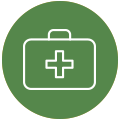Signs and symptoms of TBE
TBE is an infection of the central nervous system that affects the brain, spinal cord and membranes around them.1For most people infected with the TBE virus, there are no symptoms. But if there are, they usually appear in two phases.1
First Stage TBE Symptoms
In the first phase, people have flu-like symptoms including muscle pain, headache, fatigue and a peak temperature between 37.5ºC and 39ºC for 2 to 7 days.1 Then, there is a period of 2 to 10 days with no symptoms or mild symptoms, which is followed by the second phase.1

High Fever

Headache

Tiredness

Nausea

Muscle pain
Second Stage TBE Symptoms
With some people, the second phase can be serious. The second phase targets the brain, presenting as meningitis and/or encephalitis.2 These symptoms may include a higher fever, headache, nausea, vomiting and vertigo.1
In severe cases, permanent paralysis can occur and, in very rare cases, people may die.3
1 in 50
Up to 1 in every 50 people who develop symptoms of TBE will die from the infection4
Long-term consequences of TBE
The long-term consequences of TBE can be serious. Although most people with TBE recover fully, some patients infected with TBE will suffer severe complications with their brain, nerves and spinal cord.4
Long-term complications associated with TBE can include:2

Ataxia – a group of disorders that affect co-ordination, balance and speech

Seizures

Paralysis

Impaired consciousness
If you have been bitten by a tick or visited a TBE risk area in the past month and experience symptoms of TBE, feel unwell or the bite area does not start to heal after a couple days, contact your GP or call NHS 111. If you experience more severe symptoms, such as loss of movement in part of your body, call 999 or go to A&E.5
Explore
How to remove a tick
Find out more about how to safely and effectively remove a tick should you find one on your body.

Find out more about TBE
Find out more about TBE and how it is different from other diseases.

Find out more about the TBE risk factors
Find out your risk of TBE exposure based on where you live, where you are visiting, the time of year and activity type.